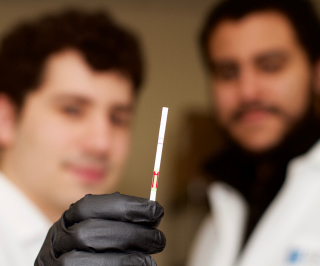
Image Credit: Zhang lab, Broad Institute of MIT and Harvard
Scientists in three studies describe how they harnessed CRISPR enzymes to develop or improve upon technology that hunts for genetic sequences linked to viruses or cancer, or capture a cell’s history. Results from all three discoveries appeared in the journal Science.
Two of the studies conducted respectively by CRISPR pioneers Jennifer Doudna, PhD, and Feng Zhang, PhD, looked beyond Cas9, a CRISPR enzyme that’s received a lot of attention for its ability to slice doubled-stranded DNA in specific areas, zeroing in on other types of enzymes as DNA sleuthing tools. Zhang’s study discusses how he and other inventors of the Specific High Sensitivity Reporter unLOCKing, or SHERLOCK, tool were able to expand its target capacity and sensitivity and refine a test format for specific use in disease outbreaks.
SHERLOCK uses a CRISPR-associated protein known as Cas13 which binds to nucleic acid material to find specific targets such as a virus or tumor DNA. Researchers developed a “version 2.0” of SHERLOCK that uses not one but three Cas13 enzymes and one Cas12a enzyme so that it senses multiple targets such as dengue and Zika virus in a single reaction. To enhance SHERLOCK’s capacity for field use, Zhang and his colleagues leveraged technology similar to pregnancy tests to create a paper test that displays results for a single genetic signature. Users dip the paper strip into a processed sample and wait for a line to appear. “The new paper readout for SHERLOCK lets you see whether your target was present in the sample, without instrumentation,” said the study’s co-first author Jonathan Gootenberg in a statement. This innovation means a field-ready diagnostic could be on the horizon for use in outbreak situations.
The SHERLOCK team also combined Cas13 with CRISPR enzyme Csm6 to increase the tool’s sensitivity by threefold. In the study, they were able to find cancer mutations in cell-free DNA from saliva samples. All of these improvements “now give us even more diagnostic information and put us closer to a tool that can be deployed in real-world applications,” said senior author Zhang, core institute member at the Broad Institute and investigator at the McGovern Institute for Brain Research at Massachusetts Institute of Technology.
Doudna, a member of the departments of Molecular and Cell Biology and Chemistry at the University of California-Berkeley, the Howard Hughes Medical Institute, and Lawrence Berkeley National Lab, and her team discovered a new behavior about CRISPR enzyme Ca12, which works similarly to Ca9 in that it uses RNA as a guide to target specific DNA. Once it recognizes its target DNA, however, Ca12 begins to cut single stranded as well as double stranded DNA. “Because this single-strand DNA threading activity is only unleashed after target binding, it can be used as an indicator of the presence of a certain target,” Science editors explained in a summary of the study’s results.
Researchers used this discovery to create a nucleic acid detection technology platform known as the DNA Endonuclease Targeted CRISPR Trans Reporter, or DETECTR. The platform combines Cas12a, its guide RNA, a fluorescent reporter molecule, and recombinase polymerase amplification to create a single reaction. “When warmed to body temperature, RPA rapidly multiplies the number of copies of the target DNA, boosting the chances Cas12a will find one of them, bind and unleash single-strand DNA cutting, resulting in a fluorescent readout,” according to a statement from UC Berkeley.
When applied to patient samples containing human papillomavirus (HPV), DETECTR was able to successfully distinguish between HPV types 16 and 18. This illustrates how sensitive and precise the test is, its authors concluded. “We want to push the limits of the technology, which is potentially applicable in any point-of-care diagnostic situation where there is a DNA component, including cancer and infectious disease,” said study author Janice Chen, a graduate student at Doudna’s lab.
In a third study, researchers Weixin Tang and David Liu, PhD, leveraged Cas9’s target and slice abilities to develop two types of cell data recorders known as CRISPR-mediated analog multi-event recording apparatus or CAMERA systems.
One of the approaches, CAMERA 1, targets cell plasmids, then monitors plasmid ratios of live bacteria cells over time, recording the history of a live bacterial cell’s exposure to nutrients, antibiotics, and other stimuli. Specifically, it records signals by changing the ratio of two DNA plasmids (A and B) in bacterial cells, using Cas9 and a guide RNA to selectively target and destroy just one of the plasmids. In the event A is destroyed, “the result is that the cell starts to replicate both A and B to fill in the loss of A. As a result, the ratio of A:B decreases over time. The more intense the signal, or the longer the signal, the lower this ratio drops,” Liu told CLN Stat.
Another approach, CAMERA 2, records signals by linking a signal of interest to the production of a base editor, “which in turn records the signal directly as a change in the DNA sequence at a specified position in the genome or in plasmid DNA,” Liu said. It works in both bacteria and in mammalian cells.
Liu said his team was able to demonstrate the ability of CAMERA 1 and 2 to record a cell’s exposure to nutrients, antibiotics, light, viruses, and even a kinase inhibitor that changes Wnt signaling in human cells. His and other labs are in the process of using the CAMERA system to study cell signaling during differentiation and other events marked by dramatic changes in cell states.